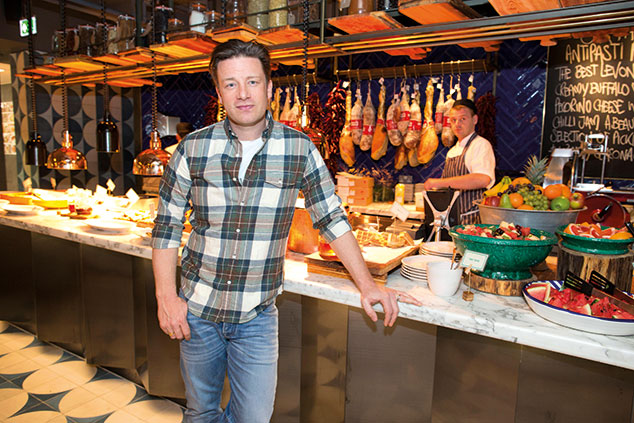
Big high-street names in the casual-dining sector have closed their doors to customers. Seems they gorged themselves too much in the good times and are now having to fast, says Simon Wilson.
How bad have things got?
The overall picture in the restaurant sector is grim, but not yet catastrophic. Last year the number of UK restaurants going bust jumped by 20% (there were 1,000 compared with 825 the year before, according to law firm Moore Stephens). In January, the burger chain Byron and Jamie Oliver’s loss-making main restaurant brand Jamie’s Italian both resorted to company voluntary arrangements (CVA) – painful restructurings aimed at fending off outright bankruptcy – in order to survive. The former is closing up to 20 outlets (a third of the total) and the latter is shutting 12 out of 37.
Last month The Restaurant Group, owner of Chiquito among other brands, reported sales down 3% in 2017 and the closure of 33 sites. Strada recently closed a third of its outlets, and the chain Square Pie went bust and closed all five of its remaining sites. And then, last month, Prezzo announced that it, too, would be slashing its estate under a CVA, closing 94 restaurants including all 33 in its Tex-Mex chain Chimichanga.
Big names, then?
Yes indeed. It’s not just fringe or underfunded outfits that are looking shaky – it’s the big, mainstream, casual-dining chains that adorn (or disfigure) every high street in the country. No doubt some of this is part of a wider consumer slowdown. Overall retail sales rose by only 0.1% in the three months to January, as rising prices and stagnating real wages took their toll – and some analysts expect that the slowdown in growth will soon have tipped into outright falls.
Already Visa’s measurement of UK consumer spending, based on card usage, showed a fall in spending last month – the first for five years. It’s not just restaurants either: retailers Toys R Us and Maplin went into administration on the same day, putting 5,500 jobs at risk in more than 300 stores. But even against this backdrop, restaurants are looking ominously wobbly.
What’s going on?
A “casual-dining crunch” it seems, with vast swathes of the UK restaurant trade – in particular the segment made up of relatively affordable, unstuffy mid-market restaurants – under intense pressure due to a lethal combination of oversupply and rising costs. The quarterly reshuffle that took place in FTSE indexes in December shone a spotlight on the structural changes facing the sector, in particular the fact that home delivery is growing ten times faster than the overall market for eating out.
The Restaurant Group, owner of Frankie & Benny’s, Chiquito and Garfunkel’s – whose shares were trading above 700p in 2015 – was finally demoted from the FTSE 250, its share price having more than halved from its peak (and it’s now down even further, at around 260p).
By contrast, Just Eat – which has none of the infrastructure of a traditional restaurant group, and simply serves as a conduit between home-diners and their favourite eateries – joined the FTSE 100 index of the UK’s biggest listed firms, having climbed steadily from about 300p three years ago to around 780p today.
Why has “casual dining” been hard hit?
It’s possible that its woes are simply more visible. Anecdotally, it’s clear that restaurants at all ends of the market are struggling. Indeed, overall, one in three of the UK’s top 100 restaurant groups make a loss (a proportion that has jumped from about a fifth in the past year), according to accountancy group UHY Hacker Young. Casual dining is proving especially vulnerable due to hubristic over-expansion – in part fuelled by cheap debt and the short-termist imperatives of some private-equity owners – in the years between 2010-16.
Restaurateur David Fox, owner of east Asian chain Tampopo, told The Guardian his tale of being offered £1.3m by his landlords – almost ten years’ rent money – to give up the leases on his sites in two massive shopping centres in Bristol and Reading so they could be re-let at doubled rents. One became a Chimichanga and is now a Real Greek; the other is now a TGI Fridays. “When someone offers you ten years’ money, it’s time to move on.”
A bubble is popping, then?
The casual-dining market definitely got giddy and now it’s dealing with the hangover. Several economic factors have come together to create a perfect storm
and now “it’s like a house of cards collapsing”, says Stefan Chomka, the editor of Restaurant magazine. “First, there’s the oversaturation. Byron expanded rapidly, Pizza Express kept adding, [as did] Nando’s and Zizzi.”
At the same time, food and staff costs, rents and business rates have all gone up, cutting margins to the bone – and encouraging the kinds of compromises on quality that can drive a spiral of decline. “And times are tough,” Chomka says. “Even if they spend a little more when they do, people are eating out less.”
What can restaurants do?
The chains weathering this storm well are brands with a distinctive offer executed brilliantly, according to analysts – such outfits as Wagamama and Nando’s. By contrast, more fuzzy, generic concepts like Zizzi or Prezzo are more vulnerable to cyclical downturns in an industry in which overcapacity is rife.
As for Jamie’s Italian, well: Jamie’s not Italian, he’s from Essex. So there’s immediately a potential lack of congruence between Jamie-the-chef and Jamie’s Italian the business proposition – especially given that Jamie-the-chef has become ever more associated in recent years with healthy eating campaigns that don’t involve ingesting lots of pasta and pizza. The new chief executive of the business, Jonathan Knight, freely concedes that the business has “lost its way” over the past two years, driven by a growing “disconnect” between the restaurant and the chef. Can he turn it round? Possibly, but don’t bet against more closures first.